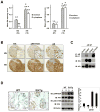Compensatory upregulation of tyrosine kinase Etk/BMX in response to androgen deprivation promotes castration-resistant growth of prostate cancer cells
- PMID: 20570899
- PMCID: PMC3464488
- DOI: 10.1158/0008-5472.CAN-09-4610
Compensatory upregulation of tyrosine kinase Etk/BMX in response to androgen deprivation promotes castration-resistant growth of prostate cancer cells
Abstract
We previously showed that targeted expression of non-receptor tyrosine kinase Etk/BMX in mouse prostate induces prostate intraepithelial neoplasia, implying a possible causal role of Etk in prostate cancer development and progression. Here, we report that Etk is upregulated in both human and mouse prostates in response to androgen ablation. Etk expression seems to be differentially regulated by androgen and interleukin 6 (IL-6), which is possibly mediated by the androgen receptor (AR) in prostate cancer cells. Our immunohistochemical analysis of tissue microarrays containing 112 human prostate tumor samples revealed that Etk expression is elevated in hormone-resistant prostate cancer and positively correlated with tyrosine phosphorylation of AR (Pearson correlation coefficient rho = 0.71, P < 0.0001). AR tyrosine phosphorylation is increased in Etk-overexpressing cells, suggesting that Etk may be another tyrosine kinase, in addition to Src and Ack-1, which can phosphorylate AR. We also showed that Etk can directly interact with AR through its Src homology 2 domain, and such interaction may prevent the association of AR with Mdm2, leading to stabilization of AR under androgen-depleted conditions. Overexpression of Etk in androgen-sensitive LNCaP cells promotes tumor growth while knocking down Etk expression in hormone-insensitive prostate cancer cells by a specific shRNA that inhibits tumor growth under androgen-depleted conditions. Taken together, our data suggest that Etk may be a component of the adaptive compensatory mechanism activated by androgen ablation in prostate and may play a role in hormone resistance, at least in part, through direct modulation of the AR signaling pathway.
Copyright 2010 AACR.
Figures





Similar articles
-
A novel androgen receptor splice variant is up-regulated during prostate cancer progression and promotes androgen depletion-resistant growth.Cancer Res. 2009 Mar 15;69(6):2305-13. doi: 10.1158/0008-5472.CAN-08-3795. Epub 2009 Feb 24. Cancer Res. 2009. PMID: 19244107 Free PMC article.
-
Neuropeptide-induced androgen independence in prostate cancer cells: roles of nonreceptor tyrosine kinases Etk/Bmx, Src, and focal adhesion kinase.Mol Cell Biol. 2001 Dec;21(24):8385-97. doi: 10.1128/MCB.21.24.8385-8397.2001. Mol Cell Biol. 2001. PMID: 11713275 Free PMC article.
-
Nrdp1-mediated regulation of ErbB3 expression by the androgen receptor in androgen-dependent but not castrate-resistant prostate cancer cells.Cancer Res. 2010 Jul 15;70(14):5994-6003. doi: 10.1158/0008-5472.CAN-09-4440. Epub 2010 Jun 29. Cancer Res. 2010. PMID: 20587519 Free PMC article.
-
Targeting tyrosine kinases and autophagy in prostate cancer.Horm Cancer. 2011 Feb;2(1):38-46. doi: 10.1007/s12672-010-0053-3. Epub 2010 Dec 2. Horm Cancer. 2011. PMID: 21350583 Free PMC article. Review.
-
Androgen receptor involvement in the progression of prostate cancer.Endocr Relat Cancer. 2003 Jun;10(2):209-16. doi: 10.1677/erc.0.0100209. Endocr Relat Cancer. 2003. PMID: 12790784 Review.
Cited by
-
CTA095, a novel Etk and Src dual inhibitor, induces apoptosis in prostate cancer cells and overcomes resistance to Src inhibitors.PLoS One. 2013 Aug 15;8(8):e70910. doi: 10.1371/journal.pone.0070910. eCollection 2013. PLoS One. 2013. PMID: 23967135 Free PMC article.
-
Structural and biophysical insights into the mode of covalent binding of rationally designed potent BMX inhibitors.RSC Chem Biol. 2020 Aug 28;1(4):251-262. doi: 10.1039/d0cb00033g. eCollection 2020 Oct 1. RSC Chem Biol. 2020. PMID: 34458764 Free PMC article.
-
Functional analyses of the bone marrow kinase in the X chromosome in vascular endothelial growth factor-induced lymphangiogenesis.Arterioscler Thromb Vasc Biol. 2010 Dec;30(12):2553-61. doi: 10.1161/ATVBAHA.110.214999. Epub 2010 Sep 23. Arterioscler Thromb Vasc Biol. 2010. PMID: 20864667 Free PMC article.
-
Induction of entosis in prostate cancer cells by nintedanib and its therapeutic implications.Oncol Lett. 2019 Mar;17(3):3151-3162. doi: 10.3892/ol.2019.9951. Epub 2019 Jan 21. Oncol Lett. 2019. PMID: 30867745 Free PMC article.
-
The expression and role of tyrosine kinase ETK/BMX in renal cell carcinoma.J Exp Clin Cancer Res. 2014 Mar 7;33(1):25. doi: 10.1186/1756-9966-33-25. J Exp Clin Cancer Res. 2014. PMID: 24606948 Free PMC article.
References
-
- Feldman BJ, Feldman D. The development of androgen-independent prostate cancer. Nat Rev Cancer. 2001;1:34– 45. - PubMed
-
- Heinlein CA, Chang C. Androgen receptor in prostate cancer. Endocr Rev. 2004;25:276– 308. - PubMed
-
- Culig Z, Klocker H, Bartsch G, Hobisch A. Androgen receptors in prostate cancer. Endocr Relat Cancer. 2002;9:155–70. - PubMed
-
- Scher HI, Buchanan G, Gerald W, Butler LM, Tilley WD. Targeting the androgen receptor: improving outcomes for castration-resistant prostate cancer. Endocr Relat Cancer. 2004;11:459– 76. - PubMed
-
- Chen CD, Welsbie DS, Tran C, Baek SH, Chen R, Vessella R, et al. Molecular determinants of resistance to antiandrogen therapy. Nat Med. 2004;10:33–9. - PubMed
Publication types
MeSH terms
Substances
Grants and funding
LinkOut - more resources
Full Text Sources
Other Literature Sources
Medical
Research Materials
Miscellaneous

